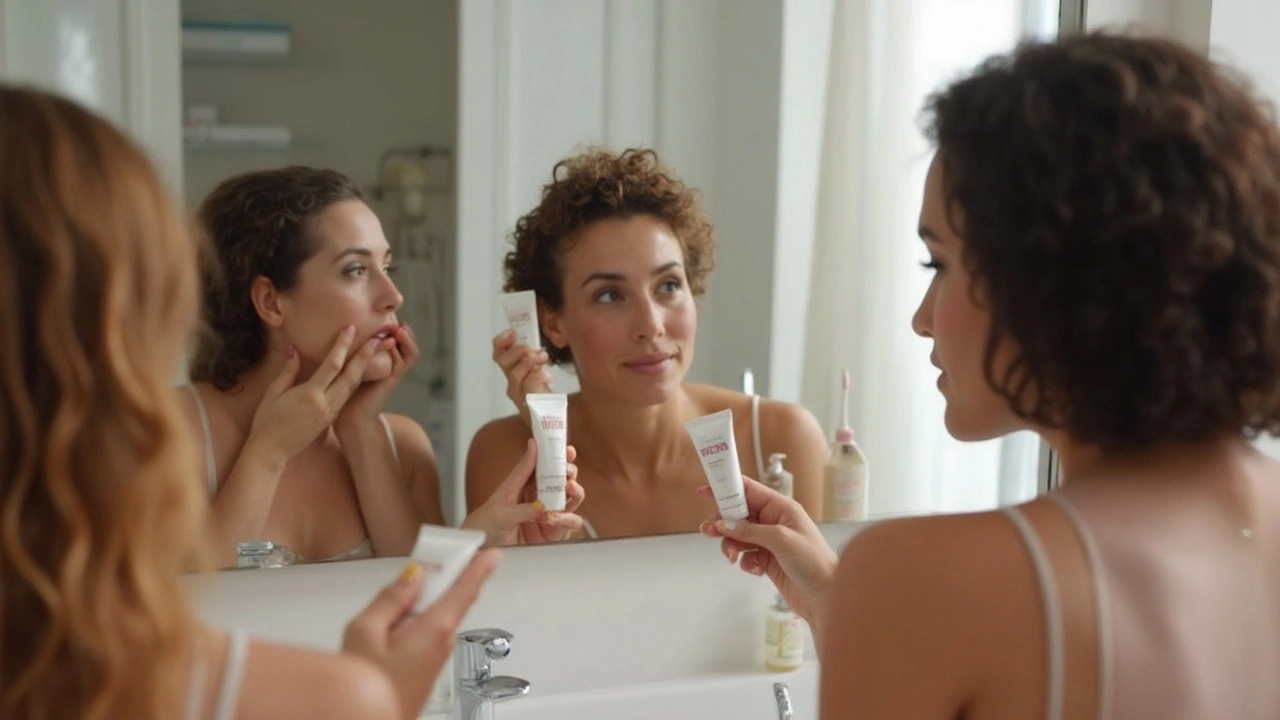
The Dark Spot Dilemma: Why Treatment Choice Matters
Most people think all dark spots are the same, but skin doesn't play by simple rules. Some folks battle post-acne marks, while others face sun spots or stubborn melasma patches. Yes, you could grab a single product off the shelf or ask your dermatologist about something stronger, but how do you know if single therapy—like just hydroquinone or just retinoid—is enough? And what about triple therapies, the infamous "bleaching creams" combining hydroquinone, tretinoin, and a steroid? Let's unmask the facts and dig deep into actual options and how they work differently.
Hyperpigmentation, technically, is the skin's way of storing up too much melanin (the pigment that makes spots brown). Your triggers could be anything from hormones to sun to picking a zit or a scratch. Here's the catch: Not all hyperpigmentation responds the same way. For some, hydroquinone alone is magic. For others—think tough melasma or big, dark patches—triple therapy becomes the only thing standing between you and clear skin. Here's where it gets interesting: in a 2023 international dermatology survey, about 63% of doctors said they start with a combination cream when patients demand fast results. That's not a random number; that's a reflection of real-life frustration when single-ingredient fixes fall short.
Still, it's tempting to start mild and slow with one agent—especially if you're new to this world, or your skin is sensitive (hello, redness and peeling). But triple therapy isn't for everyone either. Some people react to the steroid, or hate the initial irritation (sometimes called the retinoid uglies). Decisions shouldn't be guesswork. We'll break down everything you need to know: the strengths, weaknesses, side effects, and best situations for each approach. And yes, let's be real—sometimes it's not about either/or. It’s about when to start with one, add another, and maybe build up to three, for faster but safer fading.
If you’re dealing with dark spots, you want to know what really works. You’ll find endless before-and-afters on social, some with single ingredients, others with complex cocktails. The critical question is: How do these treatments really stack up against each other in clinical trials—not just on influencers' faces? Later, we'll even touch on the hot topic: how to safely switch from one to the other if your spots just won’t budge. But first, let’s see what’s actually inside these famous creams and what makes them tick.
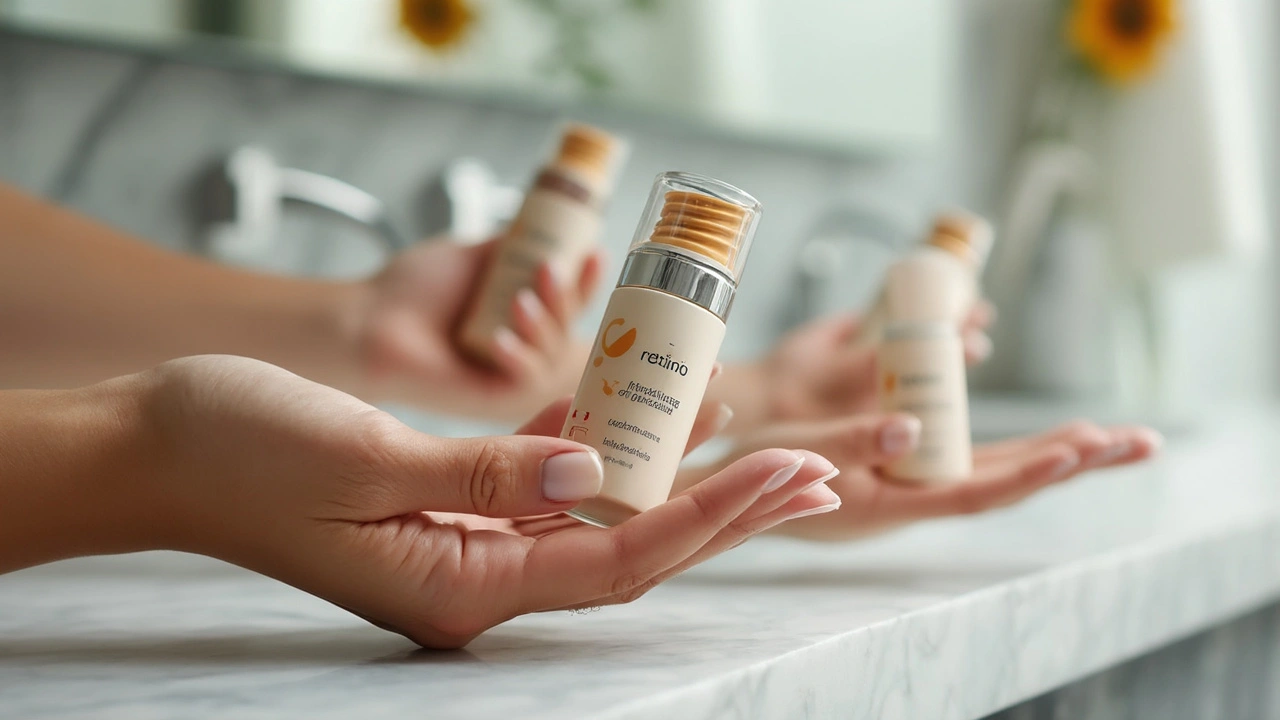
Single (Monotherapy) vs. Triple Therapy: How They Work and Who Benefits
Starting simple, "monotherapy" means you pick one main active: hydroquinone, azelaic acid, tranexamic acid, kojic acid, glycolic acid, vitamin C, or the classic retinoids (like tretinoin or adapalene). Each targets pigment in its own way. Hydroquinone, the gold standard for decades, shuts down melanin production at the source—but only if you keep up with strict sunscreen (UVA can make pigment bounce back fast). Retinoids, on the other hand, don't directly lighten, but they push your skin turnover so new, healthy cells rise faster. Vitamin C, azelaic, and kojic acids work more gently on melanin, fading spots slowly but with low risk of side effects.
Now, let's dig into triple therapy. This usually blends hydroquinone, tretinoin, and either mometasone or fluocinolone, both mild steroids. The magic’s in the synergy: Hydroquinone blocks pigment, tretinoin speeds up turnover, and the steroid calms down irritation. This combo “cocktail” has been backed by strong studies as the fastest way to clear stubborn melasma. Want a deep dive on the science? Check out this detailed guide on what is hydroquinone tretinoin used for—you'll get honest insight on ingredients, timing, and safety tips (no fluff, just facts).
When should you go single, and when triple? Here’s the honest scoop:
- First, try monotherapy if: Your dark spots are new, not too deep, or show up after breakouts. You want to avoid potential steroid risks, prefer a gentle approach, or have ultra-sensitive skin.
- Move up to triple therapy if: You've tried single agents for 8-12 weeks without much fading, your melasma or sun spots are stubborn or have sharply defined borders, or you want quick, dramatic changes. Triple therapy usually outperforms single creams in fading time—sometimes 50% faster in clinical studies.
Some tips are worth their weight in gold. Dermatologists say, “Don’t jump the gun.” Always patch test, never combine products at random, and above all, sunscreen is non-negotiable. Fun fact: skipping sunscreen can undo months of progress in a single day of outdoor fun. Also, if you’re dealing with melasma, heat—from hot yoga, saunas, or even spicy food—can flare pigment, no matter what you use.
Prescription triple creams are not a forever solution—standard protocols usually last no more than 12-16 weeks straight, to avoid skin thinning or rebound pigment. After that, most switch to maintenance with weaker agents (like azelaic or kojic acid) or just tretinoin alone. Some skin experts call it “pulse therapy”—go hard, then pull back before your skin complains.
Need numbers? Here’s a direct comparison in a 2021 clinical trial:
| Group | Median Fading Time (weeks) | Average Improvement (%) | Side Effects Rate |
|---|---|---|---|
| Monotherapy (HQ 4%) | 12 | 45 | 16% |
| Triple Therapy | 7-8 | 65 | 26% |
The short version: triple creams fade pigment faster and stronger, but at the price of more irritation, dryness, and a slight risk of skin thinning or rebound. If you’re on the fence, consider: Can your schedule handle a few weeks of possible redness or peeling for faster payoff? Or are you okay with slower, but safer steady fading?
Some people alternate: monotherapy in the morning, triple therapy at night, or use triple for a few weeks then ease off. That “stepped” approach can give you the best of both—faster results without frying your skin barrier.
“Combination therapies have truly changed the game for resistant pigment conditions, but safety and patience are everything—it's not a one-size-fits-all plan.” — Dr. Zoe Draelos, Clinical Professor of Dermatology, Wake Forest University
Remember, persistent dark spots can take months to fade. Switching treatments or quitting too soon is the most common reason people don’t get results. Patience (plus sunscreen) is your best friend, no matter what you use.

Do’s, Don’ts, and Real-World Hacks for Fading Fast without Flares
By now, you see that the smart move isn’t just picking a product, but learning how to use these therapies the right way. You want even results—no peeling, no rebound, and definitely no “halo” of light skin around each spot. Pros know it’s as much about consistency and technique as it is about ingredients.
Let’s get into some real, actionable tips:
- Always apply any fading cream *after* washing your face at night. Dry skin first prevents unwanted spread.
- Just a pea-sized amount—a thin layer, only to the dark spots. Don’t slather over your whole face unless your dermatologist says so.
- Wait 5-10 minutes before layering moisturizers, to let actives soak in and minimize irritation.
- Pair with fragrance-free, gentle moisturizers—ones with ceramides are a lifesaver for sensitive types.
- Never mix vitamin C and hydroquinone—they cancel each other out. Use vitamin C in the morning, hydroquinone at night.
- Wear SPF 30 or higher daily, even if it’s cloudy. Melanin loves any excuse to bounce back.
- Don’t layer harsh exfoliants (like scrubs, strong AHAs, or retinoids) on top of triple therapy. You’ll just peel and delay results.
- If you get irritation—back down to every other night, or cut steroid use to two weeks on, two weeks off.
Hidden tip: store hydroquinone in a cool, dark place. It oxidizes and loses kick fast if left in the sun or a steamy bathroom. You’ll get a longer shelf life (and better results) just by moving it to a cabinet.
What about side effects? Watch for redness, itching, or breakouts. With triple therapies, a faint burning is common the first few nights. Simple fix: stop, heal, and restart slow. If you get white “halo” lines or your pigment lightens unevenly, call your derm. That means the formula is too strong or being used too broadly. Permanent light spots are rare, but possible if you push too hard, too fast. That’s why pulse therapy (on for 8-12 weeks, then off or down to 2 nights a week) is most docs’ go-to advice.
For stubborn spots, especially in darker skin tones, add-ons like gentle glycolic acid peels, low-dose tranexamic acid pills, or even microneedling can boost results—but never at home for deep pigment. Those tricks belong in the clinic, not your bathroom.
Real world? People who log results in a simple notebook or photo app tend to stick with treatment longer and see better clearing. Progress is slow in the beginning—don’t stress if weeks 1-4 look the same. Most pigment starts to visibly break up around week 6-8. The trick is not to panic and jump to another new product every three weeks (the #1 mistake I see).
If you stop cold turkey after fading dark spots, rebound can absolutely happen—especially with hydroquinone or steroids. Tapering off (go to every other night, then once a week before stopping) lets your skin adapt and holds your hard-won results. Maintenance is key: even after you stop, keep up sunscreen and use a gentle fading cream (like azelaic acid) 2-3 times a week to prevent new spots from forming.
To sum up the hacks:
- Patch test everything for 24-48 hours—inside your arm works fine—before face use.
- Be consistent, but start slow (every other night for the first two weeks on triple therapy).
- Sunscreen isn’t optional, even if you work indoors. Windows don’t block UVA.
- No—your results won’t last if you drop everything the second your skin clears. Maintenance is your best bet for long-term victory.
It's easy to fall for miracle claims, but—trust me—good science (and lots of patience) win every time. If you’re not sure which plan to go with, start small with monotherapy, ramp up to triple if you’re not seeing results, and always check in with a pro if your spots are getting worse, not better. Dark spots can be stubborn, but with the right toolkit and a little perseverance, clear skin is more possible than ever.
Noah Cokelaere
Oh boy, another debate about single vs triple therapy for dark spots. I swear, every other skincare article throws triple combos at you like it’s some magic potion. But really, how different are they in practice? The article seems to give us some straight facts rather than hype, which is refreshing.
Personally, I’ve tried the single-agent route with hydroquinone, and yeah, it works but slooowly. The triple combo with retinoids and steroids sounds effective but also a bit scary with side effects. Anyone here experienced any crazy reactions?
Honestly, I’d like to know more about the synergy between ingredients. Like, are three always better than one? Or sometimes it’s just overkill? This post made me curious enough to consider switching up my routine.
Also, from a cost perspective, single therapies are usually cheaper and less complicated. Do we really need to juggle multiple ingredients every day?
To sum up, I appreciate the real talk in that article, no snake oil, just practical insights.
Narayan Iyer
Hey folks, the mechanistic pathways here are pretty interesting if you dig deeper. Triple therapy isn't just throwing three actives in a jar; it’s about targeting melanin synthesis, keratinocyte turnover, and inflammation simultaneously.
Monotherapy, like a high-concentration hydroquinone, focuses mainly on tyrosinase inhibition but might lack the exfoliative and anti-inflammatory actions.
That said, not everyone’s skin is a petri dish reacting the same way to ingredients. Genetics, ethnicity, and environmental variables complicate the efficacy optimization.
So, understanding the pharmaceutic rationale helps us tailor these therapies better. But hey, what about compliance? Juggling multiple daily steps can be a drag, especially when considering irritation risk.
Plus, the role of adjuncts like sunscreens and antioxidants can't be neglected; they often dictate how fast you see that glow-up.
Amanda Jennings
I’ve been using triple therapy for almost 3 months now, and honestly, my dark spots have faded way faster than before. I started with a single agent but got impatient with the slow progress.
The combo cream has hydroquinone, tretinoin, and a mild steroid. I was a little worried about irritation at first, but by moisturizing and using sunscreen religiously, I kept that under control.
What really helped me was following the instructions carefully and not switching products too often. Consistency is key!
It did get a bit tricky balancing everything, but after a while, it just became a routine.
Would recommend triple therapy if you can commit to the regimen and are looking for faster results.
alex cristobal roque
Adding to the conversation here, the evidence suggests that triple therapy, particularly with agents like hydroquinone, tretinoin, and corticosteroids, enhances depigmentation through combined mechanisms — pigment suppression, increased epidermal turnover, and anti-inflammatory effects.
However, one must be cautious with side effects such as irritation or potential steroid dependence with prolonged use.
For some patients, monotherapy with alternatives like azelaic acid or kojic acid might be better tolerated, especially with sensitive skin types.
Also, patch testing and gradual introduction can mitigate adverse reactions.
And don't forget, daily broad-spectrum sunscreen application is non-negotiable when using these treatments to prevent post-inflammatory hyperpigmentation recurrence.
If you’re unsure which approach suits you best, consulting with a dermatologist for tailored advice is always a smart move.
Shweta Dandekar
Frankly, I find it problematic how these so-called "miracle" triple therapies are pushed so heavily without sufficient emphasis on skin health holistically!!!
Yes, fading dark spots is desirable, but what about the long-term consequences of steroid use??? The risk of skin thinning and other irreversible damages!!!
Singular agents, especially natural and gentle ones, should be the first line of defense rather than rushing into aggressive chemical cocktails!!!
The article might be informative but slightly lacks the moral compass about advocating such potent combinations casually!!!
We must prioritize sustainable skincare practices over quick fixes!!!
Travis Evans
I totally get where you're coming from about being careful with steroids, but in my coaching experience, responsible use of triple therapy under medical supervision is like turbocharging your fight against dark spots.
Think of it as crafting a customized battle plan: the hydroquinone knocks down the pigment producers, tretinoin speeds up skin turnover, and the steroid keeps inflammation—and side effects—at bay.
Sure, safety and discipline in using them is crucial, but when done right, the payoff is major confidence boost from clearer, brighter skin quicker.
Plus, knowing your skin type, daily routine, and product interactions is key, which the article nicely emphasizes without sugarcoating stuff.
Anyone tried this combo yet and felt the difference? Would love to swap personal success stories to keep hype real and grounded!
Antara Kumar
Why are we even entertaining the western obsession with potent triple therapy here? It’s like blindly following trends without understanding the cultural and natural skincare wisdom we have traditionally!!!
Single-agent therapies have been used for decades with minimal side effects and effective results, especially with proper sun protection and lifestyle factors!!!
This forced push toward cocktails loaded with steroids feels unnecessary and even harmful!!!
One should always prioritize skin integrity and natural processes rather than chasing quick fixes marketed by big pharma and beauty conglomerates!!!
Let’s respect what’s sustainable, culturally appropriate, and scientifically sound for long-term skin health!!!
John Barton
Here we go again with the holy grail debates about dark spots. The glamorous triple therapy promises quick fix, but come on, is it really the miracle everyone makes it out to be?
Sometimes I wonder if it’s just marketing hype cloaked in medical jargon to sell more products.
The single-agent approach might take longer, sure, but it’s less likely to turn your face into a battlefield of irritation and peeling drama.
Also, think about the time, patience, and cash you need to keep up with these multi-step regimens. Not everyone's got that luxury.
Sometimes the best treatment is the simplest, folks.
Achint Patel
It's fascinating to consider how the metaphysical aspects of skin health interact with chemical treatments like these. The fading of dark spots is not merely a superficial act but a symbol of transformation and renewal in a holistic sense.
I often ponder if the reliance on aggressive triple therapy disrupts the skin's own equilibrium and self-healing properties.
We may be overlooking the philosophical implications of externally induced change versus naturally facilitated healing.
Still, if empirical results demonstrate efficacy, it challenges us to reconcile traditional wisdom with modern medical interventions.
An intriguing existential skincare dialogue, wouldn’t you say?
Duke Gavrilovic
This article is super refreshing for those who prefer clear, jargon-free info on a topic saturated with overhyped claims. The breakdown between single-agent and triple therapies is concise and understandable, making it accessible for anyone bummed about stubborn dark spots.
I appreciate how it stresses realistic expectations and prioritizing safety over quick results, which is rare these days.
Also, the insight on ingredient selection and how to minimize side effects is quite useful for casual skincare enthusiasts and newbies alike.
The inclusion of studies or clinical experience to back the claims would have been a nice addition, but still, it's a solid primer for deciding if you want to go solo or triple threat.
Louie Hadley
Reading through this and everyone’s comments got me thinking: maybe the choice between single and triple therapy really should boil down to individual goals and tolerance.
Some folks want gradual improvement and prefer minimal products, others may prioritize rapid results and accept the complexity and risks of triple combos.
It’s also encouraging that the article highlights strategies to minimize risk with triple therapy — like limiting duration and proper sun protection.
I’d be curious to see future innovations or possibly formulations that combine the best of both worlds with fewer side effects.
Overall, I’d say a personalized approach, ideally with professional advice, is the way to go.

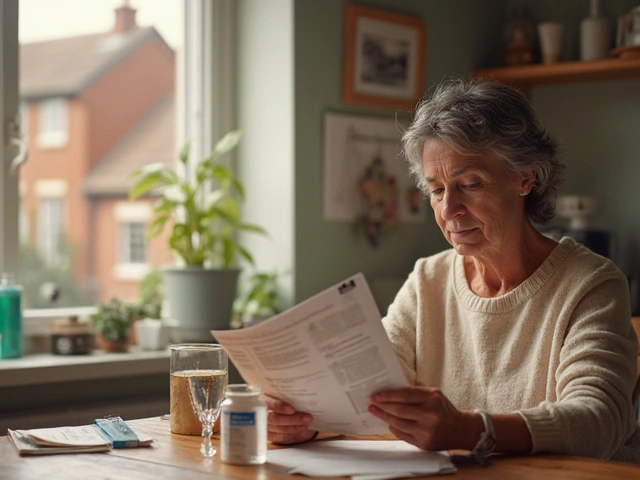

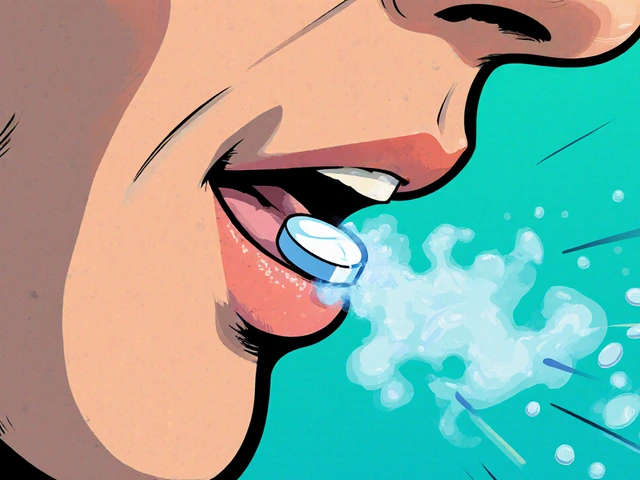
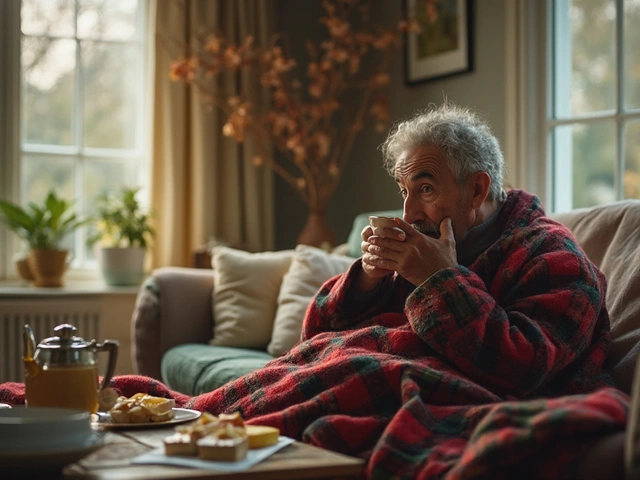

Write a comment